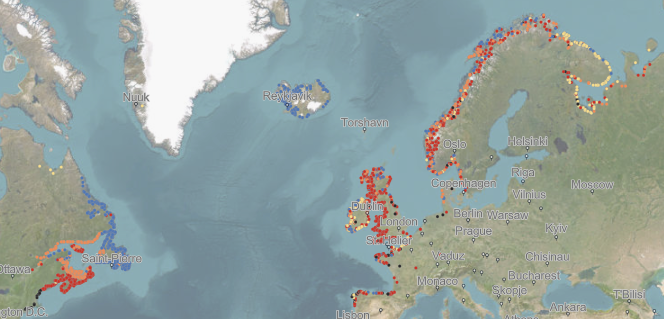Salmon in Rivers
Salmon in Rivers
In the early stages of their life cycle, Atlantic salmon spend between one and seven years in the rivers that they hatch in. When they eventually venture to sea, they travel thousands of kilometres to feeding grounds in the Norwegian or Barents Seas or to the coasts of Greenland and the Labrador Sea. Following one or multiple winters at sea, the salmon return to their rivers of origin to spawn and the life cycle begins again.

NASCO’s contracting Parties have worked to assess the status of the population, or stock, of the salmon in each river around the whole of the North Atlantic to create a new resource in the form of NASCO’s Wild Atlantic Salmon Atlas.
The Atlas is an interactive map showing the status of wild Atlantic salmon stocks in rivers around the North Atlantic.
The Status of Salmon Stocks in Rivers
In total, 2,332 rivers were reported on for 2024. Each of the rivers included in the Atlas has been assigned a ‘Risk Category’ by the Party or jurisdiction responsible for including the river. These risk categories are for use in the Atlas only and are not a scientific assessment. The categories have been assigned by translating domestic stock assessments into categories agreed by NASCO in 2022 and shown in Table 1 below.
Table 1. Risk Categories used in the Atlas
| NASCO Salmon Stock Risk Category | Description |
| Low Risk | Risks to the wild salmon population are considered to be low or absent |
| Moderate Risk | Risks to the wild salmon population are considered to be moderate |
| High Risk | Risks to the wild salmon population are considered to be high |
| Lost | Atlantic salmon no longer exist in these rivers |
| Unknown | There are known or believed to be Atlantic salmon. There are not enough data to assess their status or risk |
Each circle or dot on the maps in the Atlas represents a river, as shown below. Atlantic salmon migrate from rivers of origin to marine feeding areas. Salmon spend at least one winter at sea before making the return journey to spawn. The majority of salmon from the western Atlantic migrate to the Labrador Sea, while most salmon from the rivers of Europe, Iceland, Norway and the Russian Federation migrate to the Norwegian and Barents Seas. A small proportion of Atlantic salmon travel even greater distances across the North Atlantic to feed.

Each map in the Atlas has a pie chart associated with it that shows the current risk categories of the salmon populations, or stock, for that Party or jurisdiction. The pie chart below shows the combined information on stock status for all the rivers in the North Atlantic listed in the Atlas.

Based on the most recent information, provided by Parties and jurisdictions in 2024, the salmon stocks in approximately 37% of these rivers have been assessed as being at high risk in the NASCO salmon stock risk categories, 23% at moderate risk, 29% at low risk and the risk for 8% is unknown. Approximately a further 3% have been lost.
